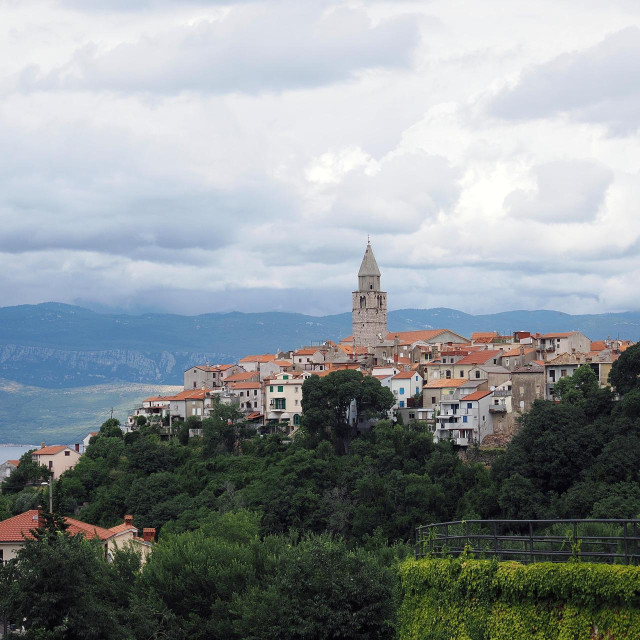If you love hidden gems that radiate that "dolce vita" vibe, visit Vrbnik on the island of Krk. It is located on the eastern coast of the island, hidden from public view, with a rich history spanning more than 900 years. The first written mention dates back to the year 1100, from the Glagolitic Charter of the famous Dragoslav, and archaeological finds confirm that this area was inhabited as far back as the Neolithic period.
The history of Vrbnik is closely connected to the powerful Frankopan princes of Krk, who originated from Vrbnik and ruled the island between 1118 and 1480. During their reign, the town experienced economic and cultural prosperity, and today the residents describe Vrbnik as a place of well-being and a destination that tourists from all over the world fall in love with at first sight.
What to see when you‘re in Vrbnik – a guide for the curious
Vrbnik is known for its unique attraction – Klančić Street, officially the narrowest street in the world, only 40 to 50 centimeters wide. This curiosity was recognized by the famous travel writer Friedrich Salomon Krauss, and today more than ten thousand tourists pass through it annually, eager to experience a walk through this narrow, yet charming street that connects the history and everyday life of the town. At its narrowest point, the street is about 40 to 43 centimeters wide, which means that two people cannot pass each other, and most passersby have to turn their shoulders to get through.
Walking through Klančić offers a special experience – the stone houses seem to lean toward each other, creating an intimate atmosphere and a sense of history woven into every stone. This street perfectly embodies the charm and authenticity of Vrbnik, a town rich in tradition, wine, and culture.
Visitor Center Baćin dvor – Guardian of Frankopan heritage
In the very heart of Vrbnik, in the historic Glavača alley, lies the newly opened Visitor Center Baćin dvor, a renovated late-Gothic building that proudly preserves and presents the town‘s rich cultural heritage. The building is part of the Frankopan legacy. Throughout history, it served as the palace of the Krk prince Bartol VII. Baćina. In more recent times, it was used as a gallery and hospitality venue, and today it has been transformed into a modern center with educational and exhibition content.
The exhibition includes three thematic sections: folk costumes and folklore customs, the 700-year-old brotherhood of St. John the Baptist – Kapare, which is still active today, and Glagolitism, whose center for centuries was precisely Vrbnik. In cooperation with the local cultural society and parish, valuable Glagolitic documents and books are exhibited. In addition to the permanent exhibition, the Center regularly hosts art workshops in drawing and wool felting during the summer, intended for both children and adults, further enriching the cultural offer and encouraging creative expression through traditional techniques. Thus, Baćin dvor becomes an essential stop for all who wish to get to know the identity and history of this unique place more deeply.
The pride of Vrbnik – Vrbnik Field and Žlahtina
The surrounding Vrbnik Field is known as an ideal area for growing Žlahtina, an indigenous wine variety that is the symbol of Vrbnik and the entire island of Krk. Žlahtina is a fresh, aromatic, and easy-drinking wine that captivates with its quality and character.
In Vrbnik‘s wineries, visitors can enjoy top-quality tastings of Žlahtina, as well as other wines produced today in the Vrbnik area. Visiting Vrbnik‘s wineries offers a unique opportunity to learn about the tradition and production process of this exceptional wine.
Everyone to the Vrbnik Wine Days
This year, Vrbnik is celebrating the jubilee 20th Vrbnik Wine Days, bringing together two decades of wine lovers and introducing visitors to the rich wine tradition of the island of Krk. Over two days, August 29 and 30, 2025, Vrbnik will become the center of wine culture, gastronomy, and entertainment. Visitors can expect a diverse program, from wine workshops and tastings, through a local products fair, to the Vrbnik Wine & Walk, a walk through Vrbnik‘s wineries with tastings of top wines and indigenous delicacies.
Music lovers can enjoy performances by Alen Vitasović, Gustafi, Klapa Kala, Trio Bajs, Night Express Band and Group Venus, while a carriage ride through the town will provide a unique experience of Vrbnik. Traditionally, wine producers from Osijek-Baranja County also participate in the event, bringing their distinctive wine character and enriching the offer. This cooperation confirms the connection between Croatian wine regions and further emphasizes the cultural diversity of the festival.















Za sudjelovanje u komentarima je potrebna prijava, odnosno registracija ako još nemaš korisnički profil....